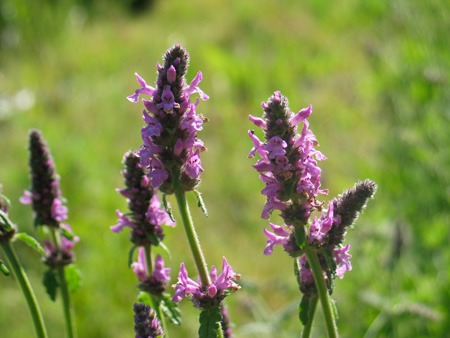
Plant Profile: Wood Betony
(Stachys officinalis)
from Herbalist Erin Smith
Wood Betony (also known as Hedge Nettle) was long revered throughout ancient Europe for its healing and magical properties. Thought of as a powerful panacea, it was the most prized medicinal plant by Anglo-Saxons and used to cure forty-seven different ailments by the Romans. However, over time its use fell out of favor and today it is used occasionally in European herbalism and rarely in North American herbalism. But it is time to rediscover and fall in love with this wonderful little beauty again.
Not to be confused with Betony (Pedicularis spp.), which is native to North America, Wood Betony is native to Europe and commonly found in dry grasslands and meadows. Traditionally, the leaves are harvested just before the plant goes to flower. But today, all aerial parts are often used when in flower. It makes a pleasant tea, with a slight spicy/aromatic flavor.
Wood Betony is an herb with specific and tonic properties. As a tonic it has long been associated with the solar plexus region of the body and is an excellent digestive tonic. It improves circulation and harmonizes the functions of the digestive system. In combination with its calming effects, it is excellent for digestive distress caused by nervous tension, anxiety, and depression. It can stimulate weak digestion while its also soothes and calms. As such, it can be great for easing the symptoms of inflammatory digestive conditions. It is slightly warming and gently invigorates the system. It stimulates the appetite and supports those that are emaciated and depleted.
It also supports a healthy nervous system, relieving stress and tension from the mind and body. So powerful, it often only takes one sip of an infusion to feel the shoulders fall and the muscles begin to melt and soften. Long associated with the head, it help relieve headaches, particularly if they are caused by tension. It is a wonderful addition to any sleep formula and helps support healthy sleep, especially if wakefulness is caused by those “churning thoughts that just wont stop.”
Wood Betony improves memory and concentration, much like Gingko, but more effective. In combination with its calming effect, it is excellent for exams and other stressful situations that require focus. It’s invigorating (without stimulating), tonifiying, and nervine properties combine to make it a wonderful herb for the elderly and those recovering from long illness. Externally, it has similar wound healing properties as yarrow and is excellent as a wash for burns.
Wood Betony is a great herb for when you just feel off but are not sure of the problem.
Historically, reverence for Wood Betony went beyond its physical health benefits., It was believed to have powerful magic and was used for protection against the evil eye and bodily harm and to bring beautiful and prophetic dreams. It dispels negative energy and eases both internal and external conflicts. All of these properties made it a popular herb in European shamanic/spiritual practices. Emotionally and spiritually, Wood Betony helps to root and ground and is perfect for those who are “spacey” and not connected to their body and the earth.
It easy to see why the Gaelic name for Wood Betony is lis bheathag, or Life Plant.
Dream Tea Recipe
1 part Linden
1/2 part Wood Betony
1/2 part Passionflower
pinch of Mugwort
Steep for minimum of 20 minutes and strain. For a stronger medicinal infusion, allow to steep for a few hours. Drink warm, an hour before bed and again right before bed.
Note: A part can be equal to any measurement you like. For example, if you decide 1 part is equal to 1 cup then for the above recipe you would add 1 cup of Linden, with 1/2 part Wood Betony and Passionflower for your tea blend. If making in larger batches, use approximately one tablespoon of this mixture for each cup of tea.
A version of this article was original published at integrativebotanical.com and is used with permission.
Image credit: https://www.herb-pharm.com/sites/default/files/wood_betony.jpg
